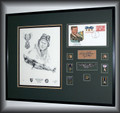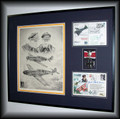 Loading... Please wait...
Loading... Please wait...Categories
Our Newsletter
- Home
- Combat Aircraft/Pencil Drawings ~ Free Shipping
- North American P-51D Mustang (Lt.Col. Glenn T. Eagleston) ~ Free Shipping
Product Description
***CLICK ON IMAGE TO ENLARGE***
Print Size 8½ x 11 ----- Unlimited print edition
Glenn Todd Eagleston (March 12, 1921 – May 7, 1991) was a career officer in the United States Air Force and the leading ace of Ninth Air Force in World War II in Europe. Eagleston was credited with 18 1/2 victories, two probable victories, and seven damaged German aircraft. He also destroyed at least five enemy aircraft on the ground, while flying P-51 Mustangs with the 354th Fighter Group. Eagleston was known as a "fighter pilot's fighter pilot." He flew almost 100 combat missions in the P-51 and P-47 in Europe, some as a 22-year-old Squadron Commander. He also flew in Korea; he was assigned there as Squadron and Group Commander, flying F-86s for 84 combat missions and being credited with two MiG-15s destroyed, one probable, and seven damaged. After a brief stint with the 79th Fighter Squadron of the 20th Fighter Group flying the P-39 Airacobra from September 1942 to January 1943, he was transferred to the 353rd Fighter Squadron of the 354th Fighter Group and deployed with that group to England in October 1943, flying P-51 Mustangs. The 354th Fighter Group, dubbed "Pioneers," started flying P-51Bs over France in December 1943. Originally part of the Ninth Air Force, the 354th was loaned to the Eighth Air Force for bomber escort duty. They received their Merlin-powered P-51Bs in November, along with Donald Blakeslee as a temporary Commanding Officer. Blakeslee led the 354th on several missions and drove the pilots hard; he insisted that they engage the German fighters and maintain a collision course, in a deadly game of aerial "chicken," counting on the Germans to break off first. The 354th flew through the bad winter weather of 1943-44, typically dividing its three squadrons into four color-coded flights of four planes each. Among the outstanding pilots of the 354th that winter were Eagleston and James H. Howard. On January 5, 1944, the 354th was covering bomber withdrawal from Kiel when they engaged a gaggle of Luftwaffe fighters. Flying at 23,000 feet, Eagleston caught an FW 190 with a short burst, at 45 degrees of deflection. The enemy aircraft dove away steeply and Eagleston pursued. Both planes accelerated rapidly; the German went into a violent, unrecoverable spin. Crashing into the ground, the Focke Wulf became Eagleston's first victory - which he might not even have hit with his machine gun fire. On the Kiel mission of January 5, the group claimed 18 enemy aircraft. Eagleston flew escort missions regularly that winter, and his score climbed: an Me-110 on January 30, single Me-110's on both February 21 and 22, and a Bf-109 on March 6, making him an ace. The 354th resumed its original tactical role in Spring 1944, in preparation for D-Day. In mid-June, the Group moved to Cricqueville-en-Bessin, an advanced base in Normandy and simultaneously returned to the Ninth Air Force command. By this time Eagleston had 8½ kills and had been promoted to Captain. Finishing his first combat, he was out of action for the summer. He returned to active duty in the fall; his biggest day was October 29, when he destroyed three Messerschmitts in a half-hour dogfight.
Eagleston was credited with 18 1/2 victories, two probable victories, and seven damaged German aircraft. He also destroyed at least five enemy aircraft on the ground.
Post-War
He served as assistant director of operations and training at Dover Field from February to June 1946, and then as commander of Dow Field from July to September 1946. Col Eagleston completed Jet Fighter Pilot School at Williams Field in January 1947, and then served at Newark, until February 1949. He served as Operations Officer for the 33rd Fighter Group at Otis Air Base from February to July 1949, and then attended Air Command and Staff School at Maxwell Air Force Base, from July 1949 to January 1950. He was then made commander of the 60th Fighter Squadron at Otis Air Base, where he served until November 1950.
Korean War
Eagleston became commander of the 334th Fighter Interceptor Squadron in Korea. He became commander of the 4th Fighter Interceptor Group in May 1951. During the Korean War, he destroyed two MiG-15s, bringing his two-war total to 20.5 enemy aircraft destroyed in aerial combat. He flew 84 missions and damaged seven and one probable. On December 22, 1950, he downed his first MiG-15 over the Yalu, one of the earliest dogfights. Eagleston's F-86A was badly damaged by a MiG-15 flown by Sergei Kramarenkoon June 17, 1951, and he belly-landed at Kimpo Air Base. The jet was damaged beyond repair and was written off. The leader of the two Sabres who came to assist Eagleston was also a notable combat pilot: Lt.Col. Bruce Hinton, the first Sabre pilot to shoot down a MiG-15 on December 17, 1950. Eagleston returned to the United States in September 1951.













